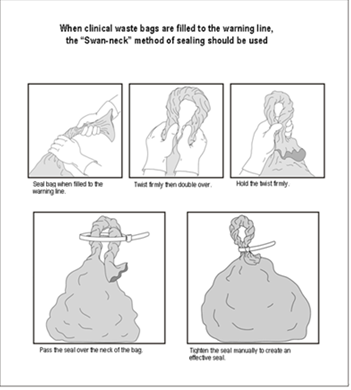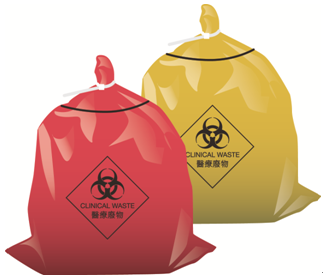Segregation, Packaging and Labelling of Clinical Waste for Small Producers
Segregation
Clinical waste should be segregated from municipal solid waste or other waste streams at the point of arising and packaged properly for on-site temporary storage in a safe and secure manner pending delivery to a collection point or licensed disposal facility. Different groups of clinical waste should be handled differently according to their packaging requirements as specified in the Code of Practice.Read More.
Packaging
Containers for packaging of clinical waste must be leak-proof, impervious to moisture and strong enough to prevent tearing or bursting under normal handling to ensure that waste handlers and the public are protected from exposure to the waste. Such containers should be of one-trip type and should not be reused. The containers should be sealed off before leaving the waste producers’ premises. The appropriate types of containers with specified colour-coding for different groups of clinical waste are set out in Table 1.
Table 1: Packaging Requirements for Different Groups of Clinical Waste
| Groups of Clinical Waste | Type(s) of Container | Colour | Sealing |
|---|---|---|---|
| Group 1 - Used or contaminated sharps | Sharps box | YELLOW or combination of WHITE and YELLOW | Proprietary closure |
| Group 3 - Human and animal tissues | Heavy duty plastic bag | YELLOW | Plastic tie |
|
Group 2 - Laboratory waste Group 4 - Infectious materials Group 5 - Dressings Group 6 - Other wastes |
Heavy duty plastic bag | RED | Plastic tie |
Group 1 Waste – Used or Contaminated Sharps
All used or contaminated sharps should be put into sharps boxes. The specifications of a typical sharps box are given in Code of Practice.
Group 3 Waste – Human and Animal Tissues
Human and animal tissues, organs and body parts should be put into YELLOW plastic bags. Such waste if generated in small quantity may be placed together with other groups of waste in RED plastic bags provided that they would not generate nuisance such as obnoxious odour. Specifications of the plastic bags are provided in Code of Practice.
Other Groups of Clinical Waste
Group 2, 4, 5 and 6 clinical waste may be placed together in RED plastic bags.
Sealing of Containers
Containers of clinical waste should not be filled above the warning line indicating between 70% and 80% of their maximum volume before sealing. The packaging and sealing should be conducted with care to ensure that no clinical waste adheres to the external surface of the containers.
Sharps containers should be properly sealed by the proprietary closure/tape. Plastic bags should be sealed by tying the neck securely to prevent spillage. The swan-neck sealing method as shown in Figure 1 is recommended.
No staple or unprotected metallic wire tie should be used for sealing or tagging of plastic bags with clinical waste, so as to prevent injury to waste handlers and damage to other bags. Metallic wire tie fully wrapped with plastic is acceptable for use in sealing plastic bags. If the clinical waste contains liquids, thermal sealing of the plastic bags is recommended to prevent spillage.
Labelling
Every container of clinical waste must bear a label as specified in Code of Practice. The label must be securely affixed or pre-printed on a prominent position of the container which allows the information on the label to be read easily. Read More.


